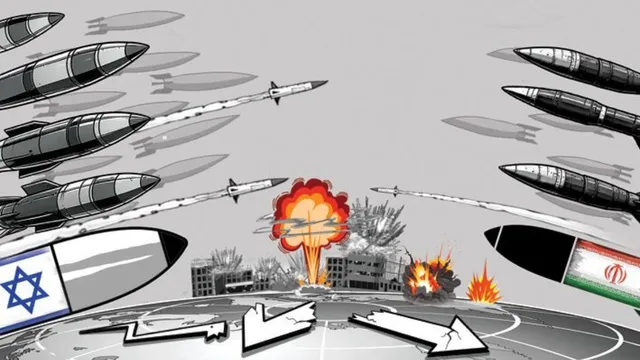- By Aditya Sinha
- Fri, 20 Jun 2025 10:50 PM (IST)
- Source:JND
The Middle East is once again on the boil. Instability is becoming the region’s default setting. In the past year alone, Israel and Iran have directly exchanged missiles, oil prices have spiked, and rival regional powers are pushing the region toward deeper fault lines. Now there is a full-scale war between Israel and Iran with both countries bombing the capitals. While the rest of the world hopes the storm will pass, the risks of a wider war, with global economic consequences, are growing by the day.
It began with a terrifying escalation. Iran and Israel, long foes through proxies and covert operations, have now entered a dangerous new phase: direct military confrontation. In April, Iran fired over 350 drones and missiles at Israel in a coordinated barrage—its first-ever strike launched from Iranian soil. Israel’s response has been swift and expansive, targeting Iranian nuclear facilities and assassinating senior Iranian commanders. For decades, both countries had operated within unspoken red lines. Now, those lines are blurred, and the region is one miscalculation away from a broader war.
The nuclear shadow hanging over this conflict cannot be ignored. Iran’s Fordow enrichment facility, buried beneath a mountain and designed to survive heavy bombardment, remains operational. Experts warn that, if Iran chooses to “break out,” it could enrich enough weapons-grade uranium for a bomb within weeks. With Israeli airstrikes damaging Iran’s other nuclear infrastructure, the fear is that Tehran may accelerate its nuclear posture, both as a deterrent and as a symbol of defiance. If that happens, it could trigger a cascade: Saudi Arabia, Turkey, and others may feel compelled to follow suit. The risk of a regional nuclear arms race, long held at bay, may now be back on the table.
Beyond Israel and Iran, Syria is becoming a renewed battleground, this time between Turkey and Israel. As Turkey increases its military footprint in post-Assad Syria, Israel has responded with airstrikes targeting Turkish-backed bases. The two regional heavyweights accuse each other of trying to carve up Syria for their own strategic interests. Meanwhile, Kurdish militias, supported by Israel and opposed by Turkey, are caught in the crossfire. Syria, once reduced to a proxy war between Iran and Gulf states, now risks becoming a three-front conflict.
All of this is happening in a region that holds the world’s energy arteries. Nearly a third of the world’s oil passes through the Strait of Hormuz, a narrow chokepoint just off Iran’s southern coast. Each escalation raises fears of shipping disruptions or even an outright blockade. It’s no wonder that oil prices surged nearly 9 per cent after Israel’s recent strikes on Iran, one of the sharpest spikes since the Ukraine war. While Brent crude settled at around $75 a barrel, analysts warn that if Iran's exports are curbed or its oil infrastructure is targeted, prices could easily shoot past $100. And in a worst-case scenario, if missile strikes hit Saudi oilfields or Iran tries to shut the Strait, prices could climb to $120 or beyond.
Markets are already jittery. The Israeli shekel has dropped sharply, and bond yields across the region, from Jordan to Egypt, have widened. Gulf stock exchanges, especially in Dubai and Abu Dhabi, saw real estate, airline, and insurance stocks plunge in a single trading day. Investors have flocked to gold and other safe-haven assets. As political risk rises, so does the fear of capital flight and prolonged volatility. And yet, we’re still in the early stages of this crisis. If the conflict widens, the financial aftershocks could be even more severe.
The diplomatic backdrop makes things even more unpredictable. US President Donald Trump has returned to office promising to be tough on Iran while continuing to back Israel. But the Gulf countries, especially Saudi Arabia and the UAE, are cautious. While they may quietly support Israel’s efforts to contain Iran, they’re also wary of being dragged into the conflict. Riyadh still remembers 2018, when it boosted oil output at Trump’s request, only to suffer when the US gave waivers to Iranian oil buyers and prices crashed. This time, Gulf states are playing their cards more carefully.
What does all this mean for the world and for India? The first and most obvious impact is energy. India imports over 80 per cent of its oil, much of it from the Gulf. If prices rise above $100 a barrel, it would lead to higher petrol and diesel costs, feeding inflation across the board. Transport, manufacturing, and food prices would all be affected.
Second, trade disruptions loom large. A significant portion of India’s trade flows through the Arabian Sea and the Strait of Hormuz. Any disruption there could choke supply chains and raise freight costs, especially for fertilizers, chemicals, and electronics.
Third, the financial impact. A prolonged crisis in the Middle East could weaken the rupee, complicate monetary policy for the Reserve Bank of India, and hit stock markets. Sectors like aviation and logistics would be among the first to feel the heat. If the conflict undermines investor confidence, capital outflows could put further pressure on the economy.
Finally, there’s diplomacy. India has carefully cultivated ties with Iran, Israel, and the Arab Gulf states. A full-scale regional conflict would test New Delhi’s balancing act. Maintaining neutrality while safeguarding strategic interests, diaspora safety, and energy security will require deft and dynamic diplomacy.
(The writer is Public Policy analyst. Views are personal.)

